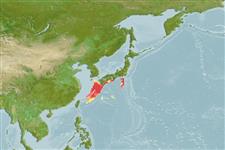Teleostei (teleosts) >
Gadiformes (Cods) >
Macrouridae (Grenadiers or rattails)
Etymology: Ventrifossa: Latin, venter, ventris = belly + Latin, fosa = pit (Ref. 45335).
Eponymy: Dr Samuel Trevor Walton Garman (1843–1927) was an American naturalist, most noted as an ichthyologist and herpetologist. [...] (Ref. 128868), visit book page.
More on authors: Jordan & Gilbert.
Environment: milieu / climate zone / depth range / distribution range
Ecology
Marine; bathydemersal; non-migratory; depth range 200 - 720 m (Ref. 1371), usually 350 - 550 m (Ref. 1371). Deep-water; 34°N - 24°N, 125°E - 140°E (Ref. 1371)
Northwest Pacific: southern Japan and East China Sea.
Size / Weight / Age
Maturity: Lm ? range ? - ? cm
Max length : 31.0 cm TL male/unsexed; (Ref. 1371)
Dorsal spines (total): 2; Anal spines: 0. Snout short, conical; eyes large, its diameter greater than snout length. Scales medium-sized, uniformly covered with broad, short, triangular spinules in widely divergent V rows or irregularly quincunx order. Snout with a black margin along its leading edge; first dorsal fin uniformly dusky or darker proximally, but lacking a distinct black blotch.
Most common in about 350 to 550 m where water temperatures range from 6° to 12°C. Feeds primarily on euphausiids, prawns, and isopods. Spawning probably takes place in early spring.
Life cycle and mating behavior
Maturity | Reproduction | Spawning | Eggs | Fecundity | Larvae
Cohen, D.M., T. Inada, T. Iwamoto and N. Scialabba, 1990. FAO species catalogue. Vol. 10. Gadiform fishes of the world (Order Gadiformes). An annotated and illustrated catalogue of cods, hakes, grenadiers and other gadiform fishes known to date. FAO Fish. Synop. 125(10). Rome: FAO. 442 p. (Ref. 1371)
IUCN Red List Status (Ref. 130435: Version 2024-2)
Threat to humans
Harmless
Human uses
Fisheries: minor commercial
Tools
Special reports
Download XML
Internet sources
Estimates based on models
Preferred temperature (Ref.
123201): 7.6 - 13.7, mean 11.1 °C (based on 21 cells).
Phylogenetic diversity index (Ref.
82804): PD
50 = 0.5000 [Uniqueness, from 0.5 = low to 2.0 = high].
Bayesian length-weight: a=0.00214 (0.00109 - 0.00421), b=3.20 (3.03 - 3.37), in cm total length, based on LWR estimates for this (Sub)family-body shape (Ref.
93245).
Trophic level (Ref.
69278): 3.5 ±0.52 se; based on food items.
Resilience (Ref.
120179): Medium, minimum population doubling time 1.4 - 4.4 years (Preliminary K or Fecundity.).
Fishing Vulnerability (Ref.
59153): Low vulnerability (21 of 100).
Nutrients (Ref.
124155): Calcium = 35.6 [19.1, 80.9] mg/100g; Iron = 0.456 [0.221, 0.929] mg/100g; Protein = 16.6 [14.8, 18.3] %; Omega3 = 0.243 [0.110, 0.515] g/100g; Selenium = 18.5 [7.3, 43.5] μg/100g; VitaminA = 12.5 [2.5, 56.8] μg/100g; Zinc = 0.476 [0.313, 0.737] mg/100g (wet weight);
